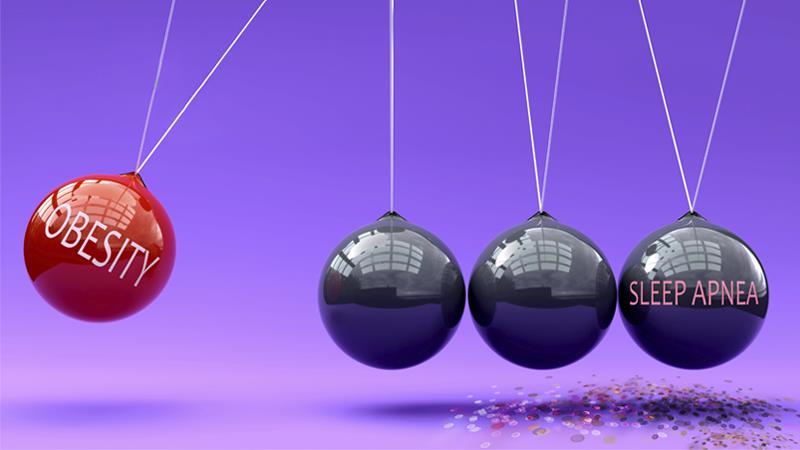Tirzepatide reduces sleep apnoea severity in obese patients





Treatment with tirzepatide significantly reduced sleep apnoea severity, as shown by a reduction in apnoea-hypopnea index (AHI), among patients with moderate-to-severe obstructive sleep apnoea (OSA) and obesity, regardless of positive airway pressure (PAP) therapy, according to two SURMOUNT-OSA trials presented at ADA 2024.
“The results have demonstrated the ability of tirzepatide to address both obesity and sleep apnoea, offering an effective and comprehensive treatment solution,” said principal investigator Prof Atul Malhotra from the University of California San Diego School of Medicine in La Jolla, California, US.
The phase III trials involving 469 adults with moderate-to-severe OSA (AHI ≥15 events/hour) and obesity (≥30 kg/m2) who were randomized to the maximum tolerated dose of tirzepatide 10 or 15 mg once weekly or placebo for 52 weeks.
Patients not on PAP therapy were enrolled in trial 1 (n=234; mean age 47.9 years, 32.9 percent female), whereas those on PAP therapy were enrolled in trial 2 (n=235; mean age 51.7 years, 27.7 percent female). [Malhotra A, et al. ADA 2024, Late-Breaking Symposium]
The efficacy estimand and treatment-regimen estimand were used in each trial to assess the primary and secondary endpoints. [N Engl J Med 2024;doi:10.1056/NEJMoa2404881]
The primary objective of the study was to demonstrate tirzepatide superior over placebo in terms of the change in the AHI, the number of apnoeas and hypopneas during an hour of sleep, from baseline to week 52.
Patients without PAP therapy
In trial 1, patients treated with tirzepatide achieved a significant decrease in AHI at week 52 than those treated with placebo for both the efficacy (-27.4 vs -4.8 events/hour; p<0.001) and treatment-regimen estimands (-25.3 vs -5.3 events/hour; p<0.001).
The percent change in AHI, a key secondary endpoint of the study, was significantly reduced by 55 percent [efficacy estimand] and 50.7 percent [treatment-regimen estimand] with tirzepatide compared with 5 percent and 3 percent, respectively, with placebo at week 52.
Patients with PAP therapy
In trial 2, tirzepatide significantly reduced AHI at week 52 for both efficacy (-30.4 vs -6 events/hour; p<0.001) and treatment-regimen estimands (-29.3 vs -5.5 events/hour; p<0.001) compared with placebo.
Similarly, the percent change in AHI at week 52 was significantly reduced by 62.8 percent (efficacy estimand) and 58.7 percent (treatment-regimen estimand) in the tirzepatide group compared with 6.4 percent and 2.5 percent, respectively, in the placebo group.
“These reductions were consistent in both trials regardless of concomitant PAP therapy and may inform treatment decisions,” the researchers said.
Additional endpoints
For the efficacy estimand, a significantly higher percentage of patients on tirzepatide achieved a ≥50-percent reduction in AHI at week 52, regardless of PAP therapy (62.3 percent vs 19.2 percent [without] and 74.3 percent vs 22.9 percent [with]; p<0.001 for both), than those on placebo.
Significantly more tirzepatide-treated patients also achieved an AHI <5 events/hour, which was considered normal, or an AHI 5–14 events/hour with an Epworth Sleepiness Scale of ≤10 at week 52 than placebo-treated patients, irrespective of PAP therapy (p<0.001 for both).
Moreover, significant reductions in the sleep apnoea-specific hypoxic burden at week 52 were observed among those treated with tirzepatide than with placebo in both trials (p<0.001 for both).
Cardiovascular-related outcomes
At week 52, in the efficacy estimand, tirzepatide significantly reduced high sensitivity C-reactive protein levels by -44.2 percent (p<0.01) in those without PAP therapy and -50.7 percent (p<0.001) in those with PAP therapy compared with placebo (-21.4 percent and -10.4 percent, respectively).
Significant improvements in systolic blood pressure were also observed among tirzepatide recipients with or without PAP therapy. “This result was probably the most striking,” noted Malhotra.
“[Tirzepatide] potential to be used alongside or independently of continuous PAP could revolutionize how we manage these interconnected conditions [sleep apnoea and obesity],” he added.